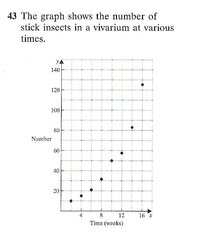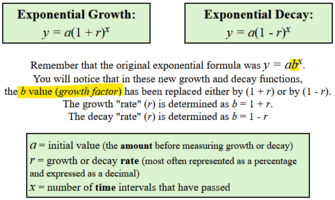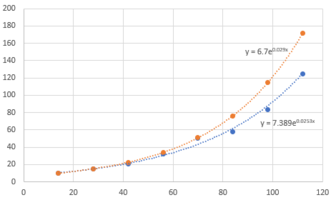Aminta_1900
New member
- Joined
- Sep 19, 2022
- Messages
- 38
This is the last question in the second modulus on calculus, which so far had dealt with the differentiation of products, quotients and functions of functions. So I am guessing that it may involve these. It shows this graph of the growth of a stick insect population over time and gives four questions.

1) "Find the growth factor between the numbers of stick insects in consecutive time intervals of two weeks. Hence find the relationship between x (time in days) and y (number of insects) that can be used as an approximate model for the data given in this graph".
The given answer is: ~1.5 and y = 6.7(15^x/14)
But I'm not sure at all how this function can be deduced from the data given.
The next three questions pertain to how I am measuring x in number of weeks, even though the question says x is measured in days.
2) "Use the model to estimate the number of insects 45 days after the first recorded entry on the graph"
Here I am taking the 45 + 14 = 59 days = 8.43 weeks, so imputing x = 8.43 into y = 6.7(15^x/14) and getting 34.2 insects as the estimate, even though the given answer is 37. Is this still a correct estimate? The question said that time should be in days rather than weeks but this would give insect growth in the 100s of thousands, which cannot be right. But the next questions throw me further off.
3) " Estimate how many days after the first recorded entry the number of insects had grown to 100"
Here, using x in weeks again, I am using 6.7(15^x/14) = 100, so changing the subject x = 13.97. 13.97 - the first two weeks = 11.94 weeks = 83.6 days, but the answer is 79 days, and the approximation is again a bit off. But is this my answer valid?
4) "Find the rate at which the numbers are growing 10 weeks after the first entry"
Here I am using the derivative of 6.7(15^x/14) as
0 * 15^x/14 + 6.7 * [ {(1 * 14) - (x * 0)}/196 ] * 15^x/14
= 0.479(15^x/14)
And imputing x = 12, as per weeks = 10 + 2 = 12. My answer is 4.88 insects per week, but the actual answer is 5.5 "per day"!
What am I doing wrong in these estimates in measuring x in weeks? or perhaps have I got the derivative wrong for the last question? Thanks a lot.

1) "Find the growth factor between the numbers of stick insects in consecutive time intervals of two weeks. Hence find the relationship between x (time in days) and y (number of insects) that can be used as an approximate model for the data given in this graph".
The given answer is: ~1.5 and y = 6.7(15^x/14)
But I'm not sure at all how this function can be deduced from the data given.
The next three questions pertain to how I am measuring x in number of weeks, even though the question says x is measured in days.
2) "Use the model to estimate the number of insects 45 days after the first recorded entry on the graph"
Here I am taking the 45 + 14 = 59 days = 8.43 weeks, so imputing x = 8.43 into y = 6.7(15^x/14) and getting 34.2 insects as the estimate, even though the given answer is 37. Is this still a correct estimate? The question said that time should be in days rather than weeks but this would give insect growth in the 100s of thousands, which cannot be right. But the next questions throw me further off.
3) " Estimate how many days after the first recorded entry the number of insects had grown to 100"
Here, using x in weeks again, I am using 6.7(15^x/14) = 100, so changing the subject x = 13.97. 13.97 - the first two weeks = 11.94 weeks = 83.6 days, but the answer is 79 days, and the approximation is again a bit off. But is this my answer valid?
4) "Find the rate at which the numbers are growing 10 weeks after the first entry"
Here I am using the derivative of 6.7(15^x/14) as
0 * 15^x/14 + 6.7 * [ {(1 * 14) - (x * 0)}/196 ] * 15^x/14
= 0.479(15^x/14)
And imputing x = 12, as per weeks = 10 + 2 = 12. My answer is 4.88 insects per week, but the actual answer is 5.5 "per day"!
What am I doing wrong in these estimates in measuring x in weeks? or perhaps have I got the derivative wrong for the last question? Thanks a lot.
Last edited:


